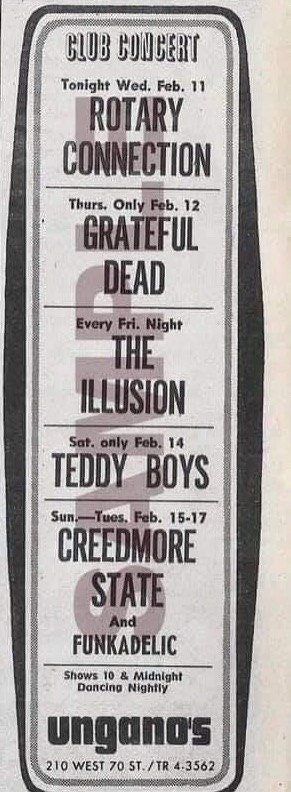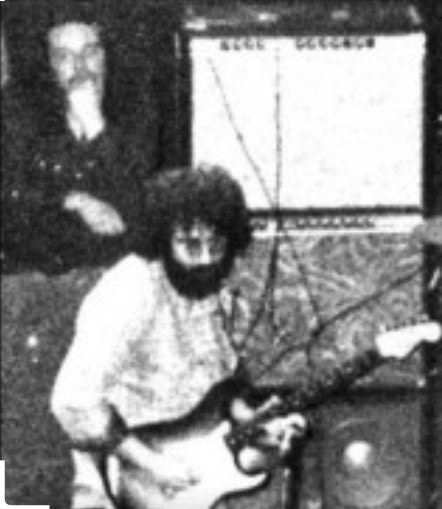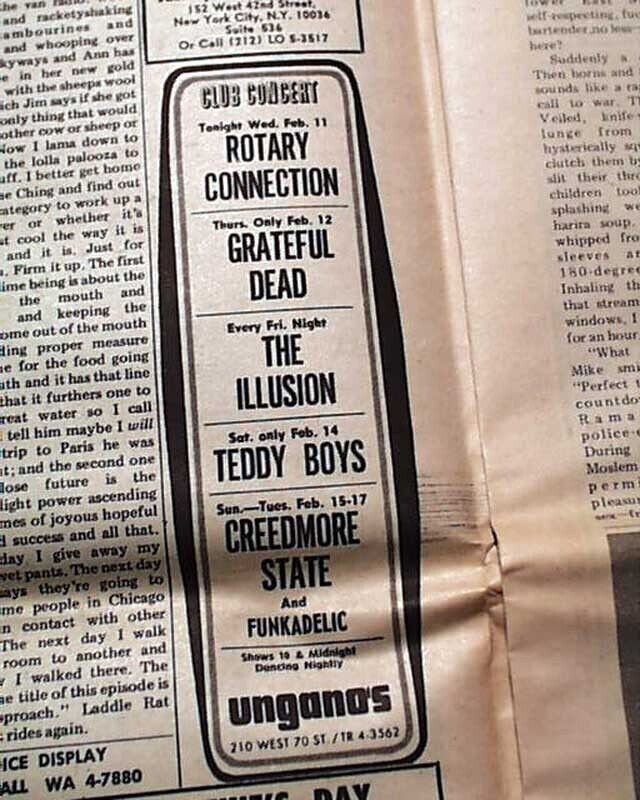February 12, 1970 Ungano's, New York, NY 210 West 70th Street The Grateful Dead
- This show was long shrouded in mystery, but Alan Mande attended it. It's a case study for how difficult it can be to confirm early Dead shows with lots of twists and turns. See the comment thread at lostlivedead. Setlist for this date comes from Jay Serafin and his Marin County contact (see his shn set info released for this date). Contrasting comments from deadlists.com: "An ad for this gig appears in the Village Voice. The 16 minute tape fragment sometimes circulated with this label is actually Fleetwood Mac w/ Peter Green, Clapton & Jr. Wells, Tea Party, Boston 2/12/70, the encore of Fleetwood Mac's set. Also, the 45 AUD tape excerpt from the 2/13/70 Early Show sometimes circulates mislabeled '2/12/70 Ungano's, for more on this tape see 2/13/70a."
Ad ad from the Village Voice of February 12, 1970, promoting a scheduled Grateful Dead show at Ungano's in Manhattan
This mysterious, somewhat controversial show was advertised on page 36 in the Village Voice of February 12, 1970 (scroll to the right of the article).The advertisement for the show in the Village Voice begs four questions
Did the event actually occur?
Why did the Grateful Dead schedule a gig at a tiny club during a Fillmore East weekend?
Why did Bill Graham allow the show to be advertised?
What were the Grateful Dead doing in New York City in the first place?
Before I discuss the club and the possible performance directly, let me take a rare sideways step to consider process, a step I normally avoid. Way back in the dark ages before the Internet, I spent a great week in New York one summer in 1983. A pioneering Deadhead friend of mine invested a bunch of money at a flea market or something to buy a huge collection of Village Voices so we could look for Grateful Dead ephemera (Bobby F--if you're out there, contact me!). Amazingly, we found this ad for the Grateful Dead playing Ungano's, a club about which we knew nothing.
At the time, the "Janet Soto" list and the Paul Grushkin Book Of The Deadheads list (just released in 1983) were the only circulating lists, so every new date was a "found date." At some point, I passed on the information about the Ungano's date, to John Dwork, Dennis McNally and John Scott of Deadbase. As the rise of Deadbase and then the Internet formalized tape trading (all for the better), various bits of knowledge began to intersect, and an audience tape began to circulate as "Feb 12 1970 Ungano's," which seemed like exciting confirmation to me that the show really occurred. Much research ensued (which can be pursued on Deadlists and elsewhere), revealing the tape to be from the early show at Fillmore East on February 13, 1970. Whatever the backstory on the tape, some probably well-meaning soul had taken a grainy audience tape and put it together with the date I had found (and no doubt confirmed by others), so rather than being "proof" of a missing show, it was in effect helping to create its own unverified verification (this is how modern political discourse works, but I digress).
I had largely forgotten about this peculiar chain of events until I recently found a quite amazing blog about NYC rock and roll venues of the prior century. It had a particularly detailed post about Ungano's, which while not revealing anything new about the Dead's performance, it caused me to rethink the gig in general. The particular question is not only whether the gig occurred, in itself an open question, but why the gig was even advertised at all, which to me is an even bigger question.
First to briefly summarize what I learned about Ungano's:
Ungano's was a club at 210 West 70th St (between Amsterdam and West End). It seems to have been open from about 1964 to 1971, and run by two brothers, Arnie and Nicky Ungano. Despite its modest size, it seemed to have been a sort of "showcase" club where major acts could play for record company people, talent agents and other important folks, and where celebrities could hang out and perhaps perform under the radar. Clubs like these are not uncommon in entertainment capitals like New York, Los Angeles or London. A comparable venue in New York was The Scene, which was a club primarily aimed at promo men and journalists.
Ungano's appearance, however, seemed to be a sort of a leftover from a prior era, according to ace researcher Mike Fornatale, who described it as "a bit of a holdover from the Copacabana Era." More intriguingly, singer Genya Ravan said, after having played the club about 1964, that it was "another Italian-owned club." This implies a mob connection, although I will say having worked in Manhattan for a number of years that many places in New York City enjoy the cachet of a rumored Mob "connection" when in fact any actual association is ancient, distant or imaginary.
The Grateful Dead at Ungano's, Manhattan February 12, 1970
Returning to our original questons about the advertisement for the show in the Village Voice
Did the event actually occur?
Why did the Grateful Dead schedule a gig at a tiny club during a Fillmore East weekend?
Why did Bill Graham allow the show to be advertised?
What were the Grateful Dead doing in New York City in the first place?
I will address these in reverse order.
What were the Grateful Dead doing in New York City in the first place?
The Grateful Dead's touring schedule for the beginning of 1970 was actually quite strange. With a new album (Live/Dead) out in November, an East Coast run at the end of 1969 made a lot of sense. New Year's Eve in Boston was followed by a weekend show at the Fillmore East on January 2-3, 1970. Presumably the band returned home, but what follows is quite odd.
January 2-3, 1970 Fillmore East
January 10, 1970 Community Concourse, San Diego
January 16-17-18, 1970 Oregon
January 23-24, 1970 Hawaii
Presumably also partially a vacation.
January 30-31, 1970 New Orleans with Fleetwood Mac
Busted down on Bourbon Street, they add an additional show on February 1
February 2, 1970 St. Louis MO
Why did they fly to St. Louis for a Monday night gig before returning home?
February 4, 1970 Family Dog, San Francisco
Filming a TV Special on a Wednesday night with Quicksilver and Santana
February 5-8 Fillmore West, San Francisco
A Thursday thru Sunday headline weekend at their home court
Why did the Grateful Dead fly to New York at all for a return gig at the Fillmore East? Sure, it was a profitable gig, but Bill Graham and the Dead had a great relationship by this time, and they could headline any weekend they wanted at the Fillmore East. The next weekend they were in Texas--why fly to New York?
The answer has to be that the Grateful Dead needed to be in New York that weekend, and Fillmore East gave them a profitable excuse to be there.
Why did the Grateful Dead schedule a gig at a tiny club during a Fillmore East weekend?
Fillmore East shows followed a very strict pattern. Headliners played double shows Friday and Saturday night, with the early show being the "industry" show for reviewers and record company types. Big acts like Crosby Stills Nash & Young, or acts popular in New York sometimes added a Thursday and/or Sunday show as well. Tuesday night was "audition night" for local bands. Any open days on Monday, Wednesday, Thursday or Sunday were sometimes filled by benefits or special events, not always involving rock acts at all.
I'm quite knowledgeable about the history of the Fillmore East, and there was no other remotely similar instance where a headliner played Wednesday night, skipped Thursday, and then headlined the weekend. This means that Bill Graham was confident he could sell out six shows, but wasn't able to book the Dead on Thursday, so he booked them on Wednesday. The only plausible explanation was that Graham knew the Dead were going to be busy Thursday, so he scheduled around it, to the mutual financial profit of all involved.
Why did Bill Graham allow the show to be advertised?
Most rock promoters were pretty benign about the fact that groups like the Dead might "drop in" around town or play a free concert. The Dead had definitively shown that the buzz was good for business. But promoters like Graham generally had strict contractual arrangements with their headliners limiting how other shows in the area could be promoted. A typical rider might be that, for example, a Fillmore East or West headliner could not have an advertised show within two weeks or 50 miles of the venue, or terms to that effect. With advance ticket sales a big part of the business, the need to insure that your headliner's presence was an "exclusive" was paramount. Graham was probably matter of fact about locally-printed flyers on telephone poles by this time, but an advertisement in the Village Voice takes some planning.
The ad for Ungano's in the February 5 Village Voice ends at February 11, and does not mention the Dead. The February 12 voice would have hit the street on Wednesday February 11, and the Grateful Dead stand out as the most prominent act. The acts listed were:
Wednesday February 11-Rotary Connection
Thursday February 12-The Grateful Dead
Friday February 13-The Illusion ("every Friday")
Saturday February 14-Teddy Boys
Sunday February 15-Tuesday February 17-Creedmore State and Funkadelic
The ad says "Shows 10 and Midnight. Dancing Nightly."
Rotary Connection were a popular psychedelic soul band from Chicago (with lead singer Minnie Ripperton) but little known outside of the Midwest. George Clinton's mighty Funkadelics had a record contract and were popular in their home base in Detroit, but unknown beyond Clinton's hometown of Plainfield, NJ.
The Grateful Dead could have packed tiny Ungano's (capacity a few hundred) with one announcement from the Fillmore East stage. Since an advertisement had the potential to violate Bill Graham's contract, why advertise the show at all, for what amounted to one day, since most people would not get in anyway? The answer has to be that Graham expected and accepted the advertised gig at Ungano's, most likely because the Dead's presence at Ungano's was the very reason he was able to book the group at Fillmore East in between weekends in San Francisco and Texas.
Did the event actually occur?
My assertion is that it was very likely the Dead played Ungano's on Thursday February 12, 1970, because that is why there in New York in the first place. The historic Fillmore East gigs were simply a profitable byproduct of the Ungano's gig, or else someone else has to find different answers to the above questions.
It is a delicious thought to think that the supposed Mob connections at Ungano's hide a secret story of wads of cash and perhaps a mobster's daughter, but I think the answer is considerably more prosaic. Ungano's was a record company hangout. Warner Brothers had invested a ton of money (125,000 1969 dollars) in the poorly-selling Aoxomoxoa, but they had a happening album on their hands with Live/Dead. The Grateful Dead had a sort of outlaw reputation in the 1960s (with some justification) but in fact they were a terrific live band willing to tour nonstop, not so common a combination as you might think. Warners probably had an inkling of what was coming on Workingman's Dead, and may have figured they had a chance to sell some records if talent agents, radio people and promotional staff got a chance to see the Dead in person.
I think the February 12 Ungano's gig was a Warner Brothers Records showcase, probably tied in with a convention or sales event at the same time. I think Warners, The Grateful Dead and Bill Graham arranged the Fillmore East gigs to happen at the same time, but Warners was driving the date. There are no tapes or eyewitness accounts of the show because no civilians got in--Warner Brothers and the club itself would have controlled the guest list.
The Dead would not have used their own sound system, since it was on the way to Texas, as they used the Fillmore East house PA while there. On an inferior sound system, its unlikely Owsley would deign to show up, much less tape. The "advertisement" in the Village Voice was to make Ungano's look cool--important in Manhattan--but a moot point since Warners had all the tickets. As such, Ungano's was not competing with the Fillmore East, assuaging any business concerns of Bill Graham. If I'm correct, it would be no surprise that Spring 1970 was when the Dead started to break out to the college market in the Northeast.
Can't prove it, probably never will. But I think in the midst of one of their great concert stands, the Grateful Dead rocked a tiny club at 210 West 70th Street.
Appendix: A Note About Peter Green
The Grateful Dead's late show on Wednesday, February 11, 1970 is one of their most legendary performances. They had met the opening act the Allman Brothers, but never heard them play until that night. Duane and Gregg Allman, Berry Oakley and Butch Trucks joined the Dead for an epic jam that included Peter Green, Danny Kirwan and Mick Fleetwood of Fleetwood Mac. What were the Mac doing at Fillmore East that night?
According to the definitive source, Christopher Hjort's book Strange Brew (Jawbone Books, 2007), the Mac were between a February 5-7 weekend at the Boston Tea Party and a Friday, February 13, 1970 gig at Madison Square Garden opening for Sly And The Family Stone. A scheduled gig at Massey Hall in Toronto was canceled, so the band came to New York early. Fleetwood Mac and the Grateful Dead had been good friends for some time, and Green had jammed with the Dead just two weeks early in New Orleans (Feb 1). Green, a fantastic guitarist himself, was particularly excited and intrigued by Jerry Garcia's creative approach to music, so its no suprise Green and other bandmembers took a free night to hang with the Dead.
Let's speculate: Peter Green loved Jerry and The Dead to the point where he dropped by Fillmore East to jam on a free night. Fleetwood Mac was on a sister label (Reprise) to Warner Brothers, just 10 weeks earlier the Mac had played four nights at Ungano's themselves (November 30-December 3, 1969), and Fleetwood Mac had no gig until Friday night. After Wednesday's epic jam, if Jerry said, "hey, we're playing uptown tomorrow night, " do you think Green missed the party?
<credit> LOSTLIVEDEAD



